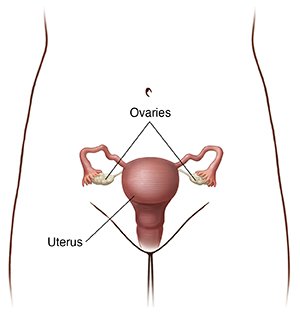We understand that gender is a spectrum. We may use gendered terms to talk about anatomy and health risk. Please use this information in a way that works best for you and your health care provider as you talk about your care.
An ovarian cystectomy is a type of surgery. It removes a cyst from your ovaries. A cyst is a sac full of fluid. You have 2 ovaries, 1 on each side of your uterus. The ovaries make your eggs (ova). They also make the hormone estrogen.
How to say it
sis-TEK-tuh-mee
Why ovarian cystectomy is done
This procedure is done to remove a cyst on an ovary. It’s usually done only if the cyst is large or painful, or if your health care provider thinks there may be cancer. Many women have cysts on their ovaries. They are often benign. But they can be cancerous.
How ovarian cystectomy is done
This procedure is often done in a hospital. You may need to spend a few days in the hospital after the cyst is removed. During the procedure:
-
You are given medicine to make you fall asleep. You won’t feel any pain.
-
The surgeon makes a cut (incision) in your belly (abdomen) to reach your reproductive organs. This procedure may also be done using a narrow tube with a camera at the end (laparoscope). The camera lets the surgeon see the cyst and guides the surgery.
-
The surgeon puts a clamp on the ovary to hold it still.
-
The surgeon carefully cuts into the ovary, revealing the cyst.
-
The surgeon may drain the cyst. It's then cut away from the ovary.
-
The cyst may be sent to a lab to check for disease, such as cancer.
-
The surgeon stops any bleeding from the ovary. They then close the cut or cuts in your belly.
Risks of ovarian cystectomy
-
Bleeding
-
Damage to an ovary or tube
-
Infection
-
Bladder injury
-
Intestinal injury
Featured in
Author: Semko, Laura
© 2000-2025 The StayWell Company, LLC. All rights reserved. This information is not intended as a substitute for professional medical care. Always follow your healthcare professional's instructions.

